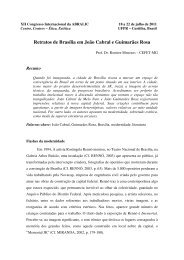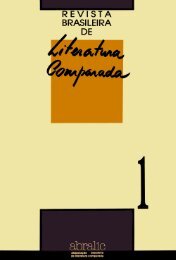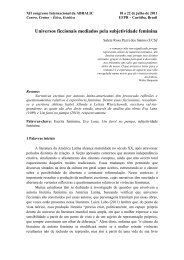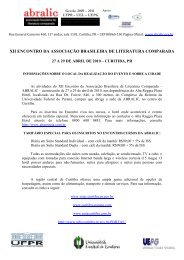Auto-ironia na obra Sayed Kashua: o antigo “humor judaico ... - Abralic
Auto-ironia na obra Sayed Kashua: o antigo “humor judaico ... - Abralic
Auto-ironia na obra Sayed Kashua: o antigo “humor judaico ... - Abralic
You also want an ePaper? Increase the reach of your titles
YUMPU automatically turns print PDFs into web optimized ePapers that Google loves.
XII Congresso Inter<strong>na</strong>cio<strong>na</strong>l da ABRALIC<br />
Centro, Centros – Ética, Estética<br />
BIBLIOGRAFIA<br />
18 a 22 de julho de 2011<br />
UFPR – Curitiba, Brasil<br />
AL-HAJ, Majid. Multiculturalism in deeply divided societies: the Israeli case.<br />
Inter<strong>na</strong>tio<strong>na</strong>l Jour<strong>na</strong>l of Intercultural Relations (Haifa, Israel), v. 26, p.169–183, 2002.<br />
BHABHA, Homi K. O local da cultura. Belo Horizonte: Editora UFMG, 1997.<br />
BTSELEM - Fatalities since the outbreak of the second intifada and until operation "Cast<br />
Lead". Disponível em www.btselem.org. Acesso em 10 de novembro de 2010.<br />
BRENNER, Rachel Feldhay. Inextricably bonded: Israeli Arab and Jewish writers revisioning<br />
culture. The University of Wisconsin Press, Madison, 2003.<br />
CENTRAL ISRAELENSE DE ESTATÍSTICAS, 2007. Disponível em www.cbs.gov.il.<br />
Acesso em 29 de novembro de 2010.<br />
COHEN, Raa<strong>na</strong>n. Zarim Beveitam: aravim, iehudim, mediná (Estrangeiros em sua casa:<br />
árabes, judeus, Estado). Tel Aviv, Israel: Ed. Dionon, 2006.<br />
ERETZ ACHERET. Chazon Arviei Israel: aravim vyiehudim mul hamismachim<br />
hechadashim (A visão futura dos árabes israelenses: árabes e judeus diante dos novos<br />
documentos). Israel, v. 39, abril-maio, 2007<br />
HALL, Stuart. A identidade cultural <strong>na</strong> pós-modernidade. Rio de Janeiro: DP&A<br />
Editora, 2005.<br />
HANDELMAN, Don. Contradições entre cidadania e <strong>na</strong>cio<strong>na</strong>lidade: suas consequências<br />
para etnicidade e desigualdade em Israel. Inter<strong>na</strong>tio<strong>na</strong>l Jour<strong>na</strong>l of Politics, Culture and<br />
Society, v. 7, n. 3, 1994 (tradução de Saul Kirschbaum – Contradictions between<br />
Citizenship and Natio<strong>na</strong>lity: Their Consequences for Ethnicity and Inequality in Israel).<br />
HAKIVUN MIZRACH – Tzoakim et shimcha beharbe leshonot: al zehut hahibridit<br />
beIsrael (Gritam o seu nome em muitas línguas: sobre identidade híbrida em Israel) (em<br />
hebraico), Tel Aviv: Ed. Bimat Kedem, 2007, v. 14, 108 p.<br />
KASHUA, <strong>Sayed</strong>. Aravim Rokdim (Árabes Dançantes) (em hebraico). Tel Aviv: Modan,<br />
2002.<br />
______________. Vaiehi Boker (Fez-se a manhã) (em hebraico). Jerusalém: Keter, 2004.<br />
______________. Guf Sheni Iachid (Segunda Pessoa do Singular) (em hebraico).<br />
Jerusalém: Keter, 2010.<br />
KIMMERLING, Baruch e MIGDAL, Joel S. Palestinians: the making of a people.<br />
Massachusetts, Cambridge: Harvard University Press, 1993.




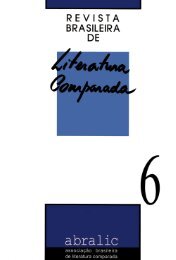
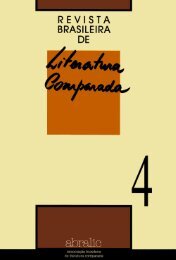

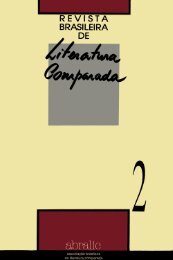
![Olhar Viajante, de Maria Lúcia Medeiros: [homo]erotismo ... - Abralic](https://img.yumpu.com/38407389/1/184x260/olhar-viajante-de-maria-lacia-medeiros-homoerotismo-abralic.jpg?quality=85)
